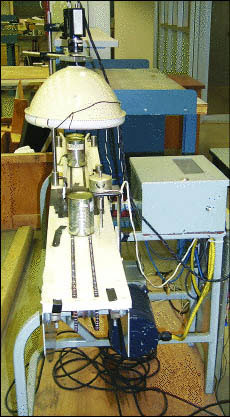
A New Angle on Fish Canning
Brent D. Johnson
Existing technology for controlling the desired net weight of canned salmon relies on volumetric principles, which can introduce unacceptable errors. Although computer tomography, positron emission tomography and magnetic resonance imaging offer alternatives to estimating density variations within an object, these techniques are costly and too slow for online measurement. Instead, researchers at the University of British Columbia are developing an optimal portioning method that uses a unique vision system.

A laser-based vision system helped automate control over the net weight of canned salmon. Courtesy of the University of British Columbia.
The weight-based portioning method developed by Clarence W. de Silva and his colleagues at the university's industrial automation laboratory will eliminate contact measuring devices, physical handling of the fish and pressure techniques. Their goals are to reduce waste, to minimize interactions of humans and machines with the product during the canning process, and to ensure the target weight of the can.
The system involves three main steps. First, the weight distribution and the geometry of each processed fish is sensed online. Second, the system finds the best-overlapped arrangement of the fish for cutting portions. Third, the best portions are identified to fill the cans, without further cutting.
A laser/vision system is the front end of an intelligent sensor for weight distribution. This detector includes a feature-driven rule-based system and model base, with nondimensional models of the weight distribution property of fish and a set of correlated simple geometric features that can be measured easily with high speed and accuracy.
The system connects a TK-1070U CCD video camera from JVC to a Sharp GPB-2 image processing board, and a laser-structured Lasiris light from StockerYale Canada. The laser source is a multiple-line structured light with a wavelength of approximately 635 nm. The laser diode generates 11 parallel lines with an interbeam angle of 1.5°. The system is capable of measuring the geometric features of two fish per second with a mean error of only 1.2 percent. The total cost of the research prototype was $10,000, but the commercial unit is expected to sell for approximately $2000.
Published: September 2002